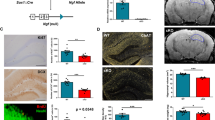Abstract
Alzheimer’s disease is a devastating degenerative disorder of the central nervous system that results in gradual deterioration of cognitive function and severe alteration of personality. Degeneration of neurons in the nucleus basalis Meynert, the origin of the major cholinergic projections to the neocortex, occurs early in the course of the disease, and is correlated with the cognitive decline. This link between cholinergic dysfunction in the basal-cortical system and cognitive deficits has focused scientific efforts on developing tools to elucidate the neurobiological role of the cholinergic system in cognition and to develop therapeutic interventions in the disorder. An important step in understanding the mechanisms underlying cognitive dysfunction has been the development of in vivo rodent models that mimic some of the features of Alzheimer’s disease. Acute excitotoxic or immunotoxic lesions of the nucleus basalis in rodents have revealed a role of the basal-cortical system in attention, learning and memory. More recent advances in developing mouse gene technology offer newer models to systematically examine the underlying neuropathological cascade leading to dysfunctions in mnemonic processing. Using in vivo rodent models, several cholinergic enhancement strategies have been tested and proven to be effective in alleviating lesion-induced cognitive deficits, including neuropharmacological approaches (acetylcholinesterase inhibitors), neurotrophic factor administration (nerve growth factor), and transplantation of cholinergic-enriched fetal grafts. Successful results have also been obtained using ex vivo gene transfer to deliver nerve growth factor or acetylcholine to compromised regions of the basal-cortical system. Gene therapy may be of particular interest for clinical applications, because this approach provides a method for topographically restricted and selective delivery of therapeutic genes and their products to afflicted areas of the brain. Advanced techniques in molecular biology (e.g., exogenous regulatable gene transfer) and newly developed tools of modern neuroscience (e.g., neural precursor cells) will be important contributions for deciphering the biological bases of neuronal degeneration and for refining therapeutic strategies for Alzheimer’s disease.
Similar content being viewed by others
Author information
Authors and Affiliations
Additional information
Received: 7 November 1996 / Accepted: 16 September 1997
Rights and permissions
About this article
Cite this article
Winkler, J., Thal, L., Gage, F. et al. Cholinergic strategies for Alzheimer’s disease. J Mol Med 76, 555–567 (1998). https://doi.org/10.1007/s001090050250
Issue Date:
DOI: https://doi.org/10.1007/s001090050250



